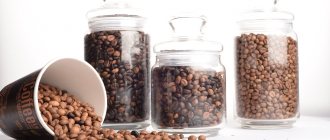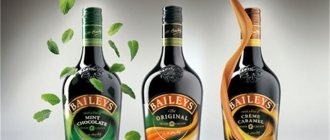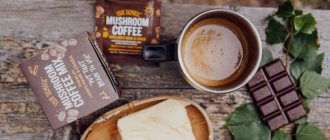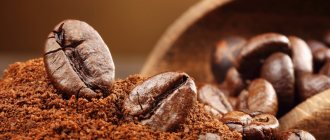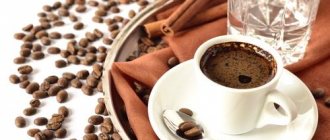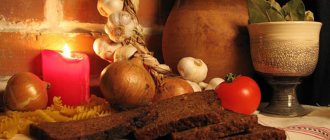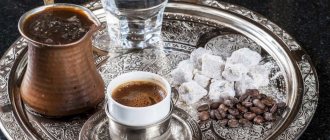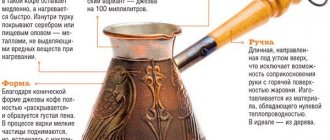Sometimes even experienced coffee lovers, reading a description of the taste of a drink made from their favorite variety of coffee beans, are amazed at how an unknown taster discovered notes of prunes, papaya and yellow raisins. Maybe stories about shades and halftones are just a cunning marketing ploy?
However, there is no deception here. The aroma and taste of coffee can truly be analyzed and each note described. This is done during the cupping process - coffee tasting. The word comes from the English cupping: cup translated means “cup”. People who professionally engage in cupping are called cuppers or cap testers. The specialty is so respected that cap testing championships are held around the world.
What is cupping
Cupping is a professional tasting process that allows you to determine the characteristics, taste and aroma of coffee. This procedure is carried out daily in roasting companies, allowing you to control the quality of roasting.
Cupping is also systematically carried out in coffee shops, where the purpose of such an event is to develop the barista’s taste experience. And finally, cupping can be done at home to learn to understand the types of energizing drinks and determine the most suitable variety for yourself.
Cupper is a person who tastes coffee. His task is to try a drink made from a particular variety and draw a conclusion based on its characteristics. There really aren't many such people. But anyone can learn this not particularly complicated process.
There is also a theory about coffee therapy. During tasting, a person can develop the functioning of his taste buds.
Objectives of coffee tasting
The objectives of the tasting are as follows:
- Calculation of certain elements that allow the correct selection of coffee beans;
- Determination of probable violations committed during the cultivation of coffee plants and/or processing technologies for already harvested coffee;
- Designation of a complete picture of sensory criteria that allows you to choose the right coffee raw materials;
- Justification for the chosen decision: how good or bad the coffee is from one or another point of view of the taster, whether the coffee has exquisite taste characteristics;
- Recording the taken “indications” about the quality of coffee, the methods of the person testing it, visual, gustatory, tactile, “smell” (including using the back wall of the pharynx) and other equally important measures.
After all, if the buyer, in general, despite the high-quality taste and consistency of the coffee, is left with an unpleasant and bitter aftertaste, giving off a feeling of bitterness in the throat, it is unlikely that he will choose this variety and name (trademark of the roasting company), which this time he was let down.
Assessment of odor and aftertaste using the back of the throat is carried out after rinsing with clean water. The taster then takes another sip of coffee.
Tasters often conduct their coffee testing in a completely clean laboratory. The fact is that coffee is sensitive to any dust or dirt - it absorbs it like a sponge, and coffee ground into a fine powder itself creates a dust curtain that comes into contact with other liquids.
Why cupping is carried out
The purpose of cupping is to reveal the flavor bouquet of each type of coffee. In order for the perception of taste buds to be as close as possible to the natural taste of the product being tasted, it must be prepared correctly.
So, the drink of vigor is brewed according to a universal recipe: ground grains are poured into a cup, after which they are poured with hot water and infused for 4 minutes. This quick recipe allows you to fully reveal the characteristics of the taste and aroma of the drink.
You need to brew coffee for cupping this way. Other options are absolutely not suitable: an unaged drink will be slightly sour, and an over-aged drink will be tart.
This is due to the specifics of each individual recipe. Therefore, if you brew a drink according to different recipes, then you absolutely cannot compare its taste characteristics and, moreover, assign it a class.
As stated earlier, tasting not only allows you to find the difference between one type of coffee or another, but also helps develop the sensitivity of your taste buds.
The taster tries different varieties, pays attention to the taste and smell of the drink and gradually begins to feel more subtle notes in the aroma, to distinguish shades of nuts, flowers, berries, and fruits in the aftertaste. And based on these characteristics and knowledge about the origin of the varieties, the capper can determine the country and region where the beans were grown.
Requirements for the taster's condition
Before cupping, you should consider that many factors change a person’s taste perception. It is distorted:
- toothpaste, cosmetics and perfumes;
- poor or too bright lighting;
- recent consumption of other foods;
- psychological and physical fatigue;
- drinking alcohol and smoking;
- Uncomfortable room temperature.
It is recommended to carry out cupping from 10 to 12 in the morning and from 16 to 18 in the evening in a well-ventilated room without extraneous sounds and odors, the temperature in which is 20-25 ° C and the humidity is 50-70%.
Specifics of cupping
Cupping is not a labor-intensive process, but at the same time it requires careful preparation and compliance with a number of rules. For tasting you will need:
- different types of coffee – 11 grams of each type;
- coffee grinder;
- cups;
- spoons;
- hot water – 200 ml for each cup;
- notepad and pen - to record the characteristics of the drink.
Important! For cupping, light/light roast coffee is most often used. Grind type: medium, coarser than espresso, close to pour-over or aeropress.
Tasting instructions:
- Evaluation of bean aroma. Pour different types of coffee beans crushed in a coffee grinder into cups, shake lightly, bring them closer to your nose and inhale the aroma. We try to feel the shade of the grains - nutty, chocolate, vanilla, floral, etc.
Advice! The closer you bring the glass of beans to your face, the brighter the aroma and the higher the likelihood of feeling the characteristic shades of the variety.
- Brew a drink of vigor. Heat the water to a temperature of 90-92°C and pour in the grains in a circular motion. A coffee cap should form on the surface of the drink. Let it brew for 4 minutes.
- Next we need to break the coffee cap and again evaluate the smell of the finished drink. Here you will need a spoon, which we immerse in a glass of coffee at an angle of 70-80° and, using 3-4 movements, move the coffee cap to the far wall of the cup. At this moment, the aroma of already brewed coffee will be released from under the thick cap - it needs to be appreciated. Therefore, when removing the cap, you need to be facing above the cup. Pay attention to changes in the smell of coffee before and after brewing.
- After removing the coffee cap, there will still be foam on the surface of the drink - we also remove it using a spoon. Let the coffee cool to a temperature of 70-80°, which may take from 8 to 10 minutes. Now you need to evaluate the taste of the drink - take a little coffee into a spoon and sharply inhale it with your mouth. The main thing is that the coffee is distributed throughout the entire oral cavity - thanks to this, it will be possible to evaluate the full picture of the taste characteristics of the product.
- We taste different types of coffee in the same way.
Be sure to read: Room area: how to understand how many square meters you need?
Evaluation procedure
First, the degree of roasting must be visually determined. This is noted on the sheet. The sequence of evaluation of each attribute is based on the change in taste caused by a decrease in temperature:
Step #1 - Aroma Within 15 minutes of the samples being ground, the dry aroma of the samples is assessed by lifting the lid and inhaling the aroma of the ground coffee. After pouring water, leave the drink untouched for 3 minutes, but no more than 5 minutes. Then the coffee is stirred three times and inhaled. The aroma rating of a drink is the total rating of dry and wet coffee aroma.
Step #2 - Flavor, Finish, Acidity, Body, and Balance Once the sample has cooled to 160°F (71ºC), 8-10 minutes after pouring in the water, the evaluation of the drink begins. The drink is absorbed into the oral cavity in such a way as to cover as much of its area as possible, especially the tongue and upper palate. Since retronasal vapors are most intense at these elevated temperatures, taste and aftertaste are assessed at this time.
As the coffee continues to cool (160ºF - 140ºF), acidity, body and balance are rated as follows. Balance is the marque's assessment of how well Flavor, Finish, Acidity, and Body work together. Cappers prefer to evaluate various attributes at multiple temperatures (i.e. 2 or 3 times) as the sample is cooled. To evaluate a sample, circle the appropriate box on the cupping form. If changes are made (if the sample gains or loses some of its perceived qualities as a result of changes in temperature), the appropriate divisions on the horizontal scale must again be marked and arrows drawn to indicate the direction of the final score.
Step #3 - Sweetness, Uniformity and Purity When the drink temperature approaches room temperature (below 100°F), then Sweetness, Uniformity and Purity are assessed. For these attributes, privateers score each individual cup, and the cup is awarded 2 points for each attribute (10 points maximum). Beverage scoring should stop when the sample reaches 70ºF (21ºC) and an Overall Score is then determined based on the combination of all attributes.
Step #4 - Scoring After scoring the samples, all scores are added up as described in the "Score" section below, and the final score is written in the upper right corner of the window by hand.
Grading Sheet and Coffee Flavor Wheel
To be able to evaluate the quality of coffee and assign a grade to it, cuppers must first undergo training at the Coffee Quality Institute, then pass 20 exams. And only in case of a positive assessment, the taster receives a certificate with which he can get a job in a coffee shop, mini-factory and roasting house.
If a person does not have the goal of working in such a position, but simply wants to learn how to cupping, then he does not have to complete CQI.
Coffee is assessed based on the following characteristics:
- Taste and aroma. This criterion is assessed by the purity and complexity of the descriptors - what can be felt in the drink. They can be floral, honey, nutty, fruity, spicy, etc. A full list of descriptors is indicated on the wheel of tastes and aromas - a special device for coffee tasters that helps determine the taste and aroma of the drink.
- Acidity. Intensity and quality are assessed. Ideally, the drink should be sweet and pleasant to the taste.
- Body. The consistency, density and quality of the drink are assessed.
- Balance. The overall impression is that the drink is balanced and complex. Determine if there are any accents that do not fit into the bouquet of taste.
- Aftertaste. An assessment is made based on the so-called aftertaste sound and the complexity of the descriptors.
- Presence of defects. Unpleasant flavors in the drink are determined: earthy, moldy, woody, chemical and other shades. To evaluate coffee according to this criterion, you need to brew the same variety in different cups and taste it.
During the cupping process, professionals enter data into an evaluation sheet, a kind of protocol in which all evaluation criteria are ordered.
Features of the capper profession
The taste of coffee depends on many factors: climatic conditions, processing method, drying, storage. Owners of roasting companies have long understood: purchasing a batch of beans without sampling is like buying a pig in a poke. Therefore, professional cappers appeared in the USA at the end of the 19th century.
The price of a batch of beans largely depends on the verdict rendered by the capper. In order to capture the slightest nuances of taste and aroma, you need to have very sensitive receptors and a subtle sense of smell. Some of these qualities are given by nature, but cappers develop them throughout their lives. Professional cap testers avoid overly salty, sour and spicy foods, and do not use perfumes or deodorants with a strong odor.
The craft is passed on from teacher to student. Maria Turi, who heads the laboratory of the Finnish company Paulig, recalls that in the 80s, young cuppers waited for her predecessor Lasse Takman to taste the coffee, carefully read his notes, and then tried the drink themselves, trying to catch the same notes as their mentor . Before becoming head capper, Ms. Turi studied with Lasse Takman for 19 years.
The American organization Coffee Quality Institute has opened an educational institution for coffee cuppers. To obtain a certificate, you need to pass 20 exams.
Typical table for professional coffee tasting
Cupping rules
In order to obtain the most realistic results during cupping, you must adhere to the following rules:
- On the day of cupping, do not wear perfume, creams or skin care products. Extraneous odors will distract from the perception of the aroma of coffee.
- Taking a full sip of coffee from a cup is not recommended. It is advisable to sip the drink sharply from the spoon - this will allow it to be completely distributed throughout the mouth, reaching all taste buds. Therefore, do not be shy about actively squelching during tasting.
- You cannot hold the cup in your hands while coffee is being brewed in it - this violates the temperature regime for brewing the drink. A cup of coffee remains on the table throughout the entire brewing procedure. It is also advisable not to move her or make any sudden movements near her.
- You should not rinse or wash the spoon while tasting one variety. It should be rinsed in a special glass of boiling water, blotted on a stack of napkins, and only then proceed to tasting another variety.
- Do not participate in cupping if you have a cold. Firstly, you endanger other participants in the event, and secondly, your taste buds practically do not work during illness, and there is no point in the procedure being carried out; you still won’t feel anything.
- Before tasting, we check each glass for cleanliness and dryness. You should also drink water to refresh and prepare your taste buds for work.
Be sure to read: What technical requirements must be met when opening a coffee shop
How to taste coffee at home
- Buy two packs of completely different coffees. It's a good idea to ask your roaster or coffee shop for advice. Comparison is very important. After all, if you try only the same coffee, then there is nothing to compare it with, unless by referring to memories, which will be fragmentary and inaccurate.
- Buy two small French presses, the smallest ones you can find, and brew two small cups of coffee. Of course, no one prohibits using large French presses and cups, but this way you will save water and coffee and will not drink too much.
- Let the coffee cool. The taste is better in a warm drink than in a hot drink.
- Try one at a time. Take a couple of sips of one drink, then move on to another. Think about how they taste different from each other. Without a reference point it is quite difficult to do this.
- First, pay attention to the texture of the drink, tactility. Maybe one coffee is denser than another? Is one coffee sweeter? Where is acidity more pronounced? Without reading the information on the package, write down a few words about your impressions.
- Don't worry if you can't differentiate the flavors. This is the part everyone dreads because failure is disappointing. Roasters describe flavor not only to emphasize certain notes, such as nutty or floral, but also to convey a wide range of sensations. By saying that coffee has notes of ripe apple, we mean that this is the kind of sweetness and acidity that you can expect from coffee. If you can distinguish individual tastes, write them down. If not, don't worry. Any words that convey your impressions will be useful.
- When you're done tasting, compare your notes with the flavor description on the package. Now do you understand what the taster wanted to say about the grains? The disappointment will disappear as if by hand if you find words on the pack that you yourself could not find, but which accurately describe the feeling of coffee. Everything will immediately seem completely obvious. This will begin the creation of your own library of coffee flavors. Every day it will become easier and easier to describe them. After all, even industry veterans continue to improve their professional vocabulary.
Where to go for cupping in Moscow
Cupping is a growing trend in the coffee industry. And if you live in Moscow, you are new to this cultural trend, and want to go to a coffee tasting, then we offer you a list of establishments where such events are systematically held:
- Cherny cooperative, Lyalin lane, building 5, building 1. Cupping is held every Sunday at 11:00. They taste their own grain and the grain of other roasters, both domestic and foreign.
- Point coffee & food, Sadovnicheskaya embankment, 75. Cupping is carried out 2 times a month.
- West 4 roasters, Olkhovskaya street, building 14, building 8, Aviator Art Space. Coffee tastings are held irregularly.
- coffee&lab, Novodmitrovskaya street, building 1, building 1. Tasting is rarely held. Large, spacious hall, specially equipped for cupping.
- Coffee shop DoubleB. Check with the barista for the cupping schedule. They drip their own roasted grain, sometimes grain from international championships or experimental samples.
